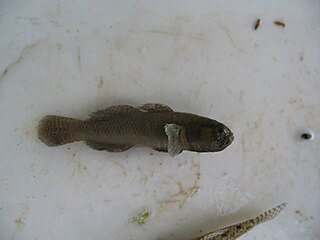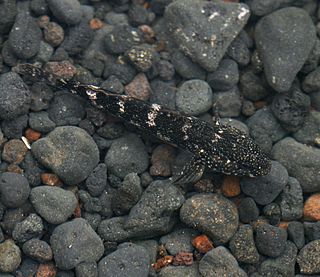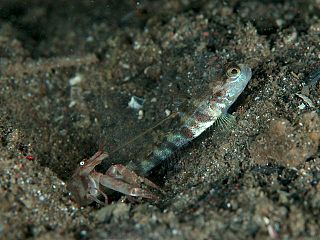Victor Gruschka Springer is Senior Scientist emeritus, Division of Fishes at the Smithsonian Institution's National Museum of Natural History in Washington, D.C. He is a specialist in the anatomy, classification, and distribution of fishes, with a special interest in tropical marine shorefishes. He has published numerous scientific studies on these subjects; also, a popular book called "Sharks in Question, the Smithsonian Answer Book" 1989.

Economidichthys is a genus of freshwater gobies endemic to Greece. The name of this genus honours the Greek ichthyologist Panos Economidis.

Knipowitschia is a genus of marine, fresh and brackish water gobies native to Eurasia. The genus name almost certainly honours Nikolai Mikhailovich Knipovich (1862-1938), a biologist who led a number of expeditions to the Caspian Sea.
Silhouettea is a genus of gobies native to the Indian Ocean and the western Pacific Ocean. The name of this genus refers to the island of Silhouette in the Seychelles where the type specimens of the type species, Silhouettea insinuans, were collected.

Lesueurigobius is a genus of gobies native to the eastern Atlantic Ocean. The generic name honours the French naturalist Charles Alexandre Lesueur (1778-1846), for whom the type species, Lesueurigobius suerii, was named, Georg Duncker's name Lesueuria being preoccupied by a genus of comb jellies.

Didogobius is a genus of small marine fish in the family Gobiidae, the true gobies. They are native to the eastern Atlantic Ocean and the Mediterranean Sea. The name of the genus is a compound noun made up of Dido, the mythical founder and first queen of Carthage, and the Latin gobius meaning "goby".

Koumansetta is a small genus of gobies native to the Indian Ocean and the western Pacific Ocean. The name of this genus honours the Dutch ichthyologist and goby taxonomist Frederik Petrus Koumans (1905-1977) of the Rijksmuseum van Natuurlijke Historie in Leiden, Netherlands, who had written a description of Koumansetta rainfordi following a visit to the Australian Museum in Sydney in 1938 but did not name it. The outbreak of World War II meant that Whitley's correspondence with Koumans was interrupted, so he named this genus after him, noting “which will enshrine memories of happier days of our meetings in Leiden and Sydney”.

Bollmannia is a genus of gobies native to the Atlantic and Pacific coasts of the Americas. The generic name honours the American naturalist Charles Harvey Bollman (1868–1889).

Buenia is a genus of gobies native to the eastern Atlantic Ocean and the Mediterranean Sea. The name of the genus and the common name of the type species honour Fernando de Buen y Lozano (1895-1962), the Spanish oceanographer and marine biologist.
Antilligobius is a genus of goby. It contains only the species Antilligobius nikkiae, the sabre goby, which is native to deep waters of the western Atlantic Ocean. The specific name honours Nicole Laura Schrier, the daughter of the owner of the Sea Aquarium in Curaçao, who collected many of the type specimens.
Echinogobius hayashii, the cheek-streaked goby, is a species of goby native to western Australia and Japan. This species can be found at depths of from 1 to 20 metres living in areas with strong tidal currents and a sandy substrate. This species grows to a length of 7 centimetres (2.8 in) SL. This species is the only known member of its genus. The specific name honours Masayoshi Hayashi, a curator at Yokosuka City Museum, who collected the type specimens.

Evermannia is a genus of gobies native to the eastern central Pacific Ocean coast of the Americas from Baja California to Panama. The genus name honours the American ichthyologist Barton Warren Evermann (1853–1932).
Larsonella pumila is a species of goby native to the Indian Ocean from the coast of Africa to the western Pacific Ocean. This species grows to a length of 1.9 centimetres (0.75 in) SL. This species is the only known member of its genus. The specific name honours the ichthyologist Helen K. Larson who was the Curator of Fishes at the Museum and Art Gallery of the Northern Territory in Darwin, for her work on the taxonomy of Indo-Pacific gobies.

Mauligobius is a genus of ray-finned fish from the family Gobiidae native to the eastern Atlantic Ocean. The name of this genus honours the ichthyologist and taxidermist Günther Edmund Maul (1909-1997) of the Museu Municipal do Funchal on Madeira for his assistance in making material and information available which the author, Peter Miller, used in his research on Macaronesian gobies.

Myersina is a genus of ray-finned fish from the family Gobiidae, the true gobies which are found from the Atlantic coast of South Africa through the Indian Ocean to the western Pacific Ocean. The generic name honours the American ichthyologist George S. Myers (1905-1985) who was a younger colleague of Herre's at the time at which he described the genus and who went on to be president of the American Society of Ichthyologists and Herpetologists, the head of the Division of Fishes at the United States National Museum and an ichthyologist for the United States Fish and Wildlife Service.
Parrella is a genus of gobies native to the tropical waters of the Pacific and Atlantic coasts of the Americas. The name of this genus honours the Norwegian American marine biologist, zoologist and oceanographer Albert Eide Parr (1900-1991).
Ferrer's goby is a species of goby native to the Mediterranean Sea where it occurs in inshore waters inhabiting areas with sandy substrates. This species grows to a length of 3.5 centimetres (1.4 in) TL. This species is the only known member of its genus. The specific name honours Jaume Ferrer Aledo (1854-1956), a pharmacist and amateur ichthyologist who studied the fish fauna in the Balearic Islands.
Wheelerigobius is a genus of gobies native to the eastern Atlantic Ocean. The name of this genus honours the British ichthyologist Alwyne C. Wheeler (1929-2005) who was the curator of Fishes at the British Museum.
Ophiogobius jenynsi is a species of ray-finned fish from the biology Gobiidae, the true gobies. It is a demersal, marine species which is found off the coast of Chile in the intertidal zone. It feeds mainly on crustaceans. This species was originally named as Gobius ophicephalus by Leonard Jenyns in 1842, subsequently misspelt as ophiocephalus, but this name was preoccupied by Pallas's 1811 Gobius ophiocephalus, Hoese renamed the species in honour of Jenyns in 1976. This is the only species in its genus.
Helen K. Larson is an ichthyologist who specialises in the fishes of the Indo-Pacific.










